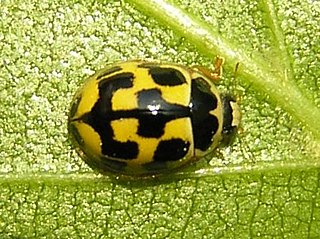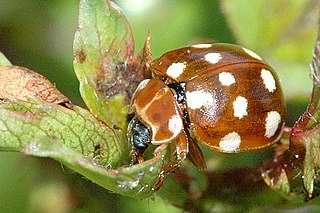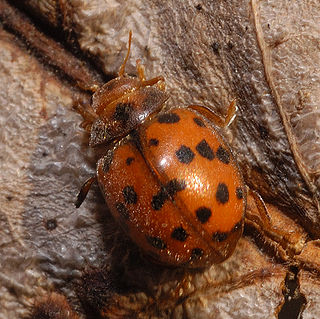Michael Eugene Nicolas Majerus was a British geneticist and professor of evolution at the University of Cambridge. He was also a teaching fellow at Clare College, Cambridge. He was an enthusiast in Darwin's theory of evolution by natural selection and became a world authority in his field of insect evolutionary biology. He was widely noted for his work on moths and ladybirds and as an advocate of the science of evolution. He was also an enthusiastic educator and the author of several books on insects, evolution and sexual reproduction. He is best remembered as an ardent supporter and champion of experiments on peppered moth evolution.

Harmonia axyridis, most commonly known as the harlequin, multicolored Asian, or Asian ladybeetle, is a large coccinellid beetle. This is one of the most variable species in the world, with an exceptionally wide range of color forms. It is native to eastern Asia, but has been artificially introduced to North America and Europe to control aphids and scale insects. It is now common, well known, and spreading in those regions, and has also established in Africa and widely across South America. This species is conspicuous in North America, where it may locally be known as the Halloween ladybeetle. It earns this name as it often invades homes during October to overwinter.

The term melanism refers to black pigment and is derived from the Greek: μελανός. Melanism is the increased development of the dark-colored pigment melanin in the skin or hair.

Laothoe populi, the poplar hawk-moth, is a moth of the family Sphingidae. The species was first described by Carl Linnaeus in his 1758 10th edition of Systema Naturae. It is found throughout the Palearctic region and the Near East and is one of the most common members of the family in the region. It is distinctive due to its habit of resting with its hindwings held further forward than the forewings.

Industrial melanism is an evolutionary effect prominent in several arthropods, where dark pigmentation (melanism) has evolved in an environment affected by industrial pollution, including sulphur dioxide gas and dark soot deposits. Sulphur dioxide kills lichens, leaving tree bark bare where in clean areas it is boldly patterned, while soot darkens bark and other surfaces. Darker pigmented individuals have a higher fitness in those areas as their camouflage matches the polluted background better; they are thus favoured by natural selection. This change, extensively studied by Bernard Kettlewell, is a popular teaching example in Darwinian evolution, providing evidence for natural selection. Kettlewell's results have been challenged by zoologists, creationists and the journalist Judith Hooper, but later researchers have upheld Kettlewell's findings.

Coccinella septempunctata, the seven-spot ladybird, is the most common ladybird in Europe. Its elytra are of a red colour, but punctuated with three black spots each, with one further spot being spread over the junction of the two, making a total of seven spots, from which the species derives both its common and scientific names.

The 14-spotted ladybird is a small lady beetle, belonging to the family Coccinellidae. It is sometimes referred to by the common name 14-spotted ladybird beetle, or simply P-14.

Coccinellidae is a widespread family of small beetles ranging in size from 0.8 to 18 mm. The family is commonly known as ladybugs in North America and ladybirds in Britain and other parts of the English-speaking world. Entomologists prefer the names ladybird beetles or lady beetles as these insects are not classified as true bugs.

Myzus persicae, known as the green peach aphid, greenfly, or the peach-potato aphid, is a small green aphid. It is the most significant aphid pest of peach trees, causing decreased growth, shrivelling of the leaves and the death of various tissues. It is also acts as a vector for the transport of plant viruses such as cucumber mosaic virus (CMV), potato virus Y (PVY) and tobacco etch virus (TEV). Potato virus Y and potato leafroll virus can be passed to members of the nightshade/potato family (Solanaceae), and various mosaic viruses to many other food crops.

Harmonia conformis is a species of ladybird. It has a light reddish appearance and its colouration includes 20 large black spots, 18 of which are found on the elytra. They are quite large for ladybirds, being about 6–7 mm long. It is a predator of other insects, eating aphids as both a larva and imago (adult). It is found in Australia, and has been introduced to New Zealand, where it is common in northern regions. Another member of the same genus, Harmonia antipoda, also occurs in New Zealand. This species, however, is a native and is much smaller and harder to find.

Coccinella leonina, common name orange-spotted ladybird, is a species of ladybird native to New Zealand. It is black with orange spots. It is present in a variety of habitats and is a predator species.

Adalia decempunctata, the ten-spotted ladybird or ten-spotted lady beetle, is a carnivorous beetle of the family Coccinellidae.

The cream-spot ladybird is a species of ladybird in the family Coccinellidae. Its distribution is holarctic, it being found in Europe and through the East Palearctic to Japan. It is introduced to North America. This ladybird is generally 4 to 5 millimetres in length and varies in appearance depending on the geographical location. It usually lives in hedgerows and deciduous trees.

Coleomegilla maculata, commonly known as the spotted lady beetle, pink spotted lady beetle or twelve-spotted lady beetle, is a large coccinellid beetle native to North America. The adults and larvae feed primarily on aphids and the species has been used as a biological control agent. Based on name connotation and to avoid confusion with other species also called "spotted ladybeetle", spotted pink ladybeetle is probably the most appropriate common name for this species.
Dinocampus coccinellae is a braconid wasp parasite of coccinellid beetles, including the spotted lady beetle, Coleomegilla maculata. D. coccinellae has been described as turning its ladybird host into a temporary "zombie" guarding the wasp cocoon. About 25% of Coleomegilla maculata recover after the cocoon they are guarding matures, although the proportion of other ladybird species which recover is much lower.

Exochomus quadripustulatus, common name pine ladybird or pine lady beetle, is a species of beetle of the family Coccinellidae. The distribution range of Exochomus quadripustulatus includes Europe & Northern Asia and North America.

Subcoccinella vigintiquatuorpunctata is a beetle in the family Coccinellidae. It is the only member of the genus Subcoccinella. It has the typical, almost semi-spherical, ladybird shape and is patterned with spots. However it differs from many of the well-known ladybirds in being neither smooth and shiny nor an eater of aphids: the wing-cases look velvety and it eats fungal moulds on plants.
Dinocampus coccinellae paralysis virus (DcPV) is a single-stranded, positive-sense RNA virus of insects, in the picorna-like virus family Iflaviridae, which was first characterised in 2015. It asymptomatically infects the parasitic braconid wasp, Dinocampus coccinellae, and has been proposed to be associated with the paralytic effect the wasp has on its host, the spotted lady beetle, Coleomegilla maculata, which it turns into a so-called "zombie bodyguard" for its pupa.
Aphidius nigripes is a species of parasitoid wasp in the subfamily Aphidiinae of the family Braconidae. It is the most common parasitoid of the potato aphid Macrosiphum euphorbiae in eastern North America. Many other species of aphids may also serve as hosts.

Tillus elongatus is a species of beetle in the Family of checkered beetles Cleridae. It is found in the Palearctic. The “Holz” in the German common name Holzbuntkäfer indicates that these checkered beetles are found in wood. Although Tillus elongatus can reach up to a size of 1 cm long, the beetle is rarely seen by humans, as it primarily resides hidden in the wood of trees. The colouration of the males differs from that of the females.






















